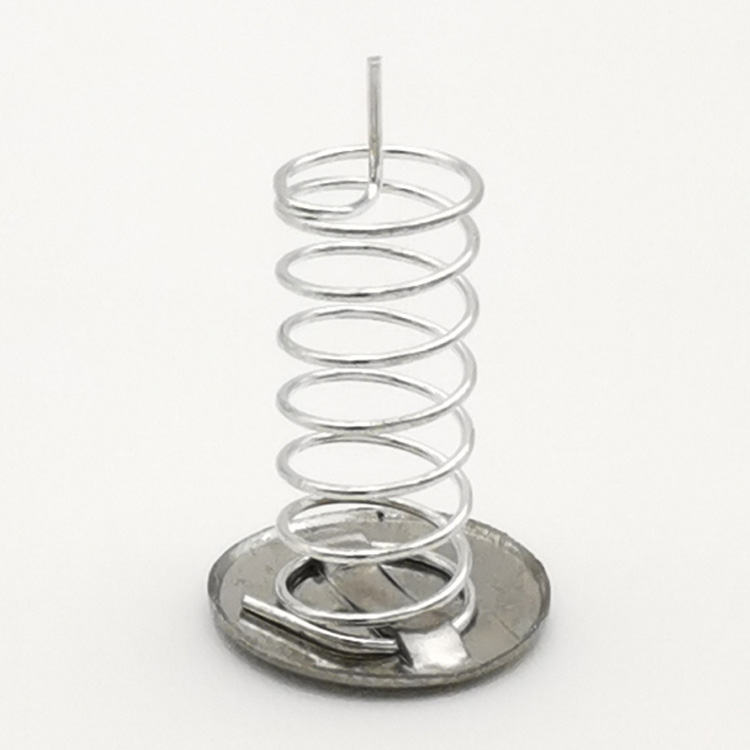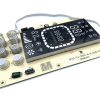
=Brief introduction of several hot sale compression springs
/products/compression-spring.html
Extension Spring is a tight circle around it so that it can be stressed and stretched. Each end is wrapped with a loop (Loop). The following is the necessary information for the extension spring:
(1) Free length: (a) the total length, (b) the length of all circles, (c) the length inside the hook and loop.
(2) Control diameter: (a) outer diameter, (b) inner diameter, (c) casing inner diameter.
(3) Wire size "wire diameter".
(4) Material (type, grade).
(5) Number of turns: (a) Total number of turns and (b) Right or left.
(6) End form.
(7) The load in the hook.
(8) Load rate, deflection, pounds/inch.
(9) Maximum stretch length.
Extension Spring is a typical spring, from straight to various variants, and even various shapes of hooks can be designed according to the design.
Extension Spring is the reverse use of compression spring. Its application range is wider than that of specific product categories, but the level of operation control compression spring is higher.
Compression spring (compression spring)
It is round, because it can bear pressure, the two ends can be opened and closed, and can be flat and ground. The following is the necessary information for compression springs:
(1) Outer diameter (a) Outer diameter, (b) Inner diameter, (c) Casing inner diameter, (d) Round rod outer diameter.
(2) Wire or bar size.
(3) Material (type and grade).
(4) Number of turns: (a) Total number of turns and (b) Right or left.
(5) Style of Ends.
(6) Load under the length of the bending zone.
(7) Load ratio in the range of inches to several inches.
(8) "Maximum solid height" (Maximum solid height).
(9) Minimum compression during use.
Compression Spring (Compression Spring) is the first variant of the spring, from straight, tapered to reduced waist, convex waist, and even a variety of tail changes, which can be designed according to the design.
Compression springs are the most widely used of all spring types. Its products are used in a wide range of industries, including electronics, motors, computers, information, steam locomotives, bicycles, hardware tools, gifts, toys and even the defense industry. The design and principle are easy to master, and the manufacturing control is also the simplest.
Torsion spring
Each ring surrounds either closely or separately so as to be able to accommodate reverse loads (at right angles to the spring axis). The end of the spring can be wound into a hook or straight torsion arm. The following is the necessary information for torsion springs:
(1) Free length.
(2) Control diameter: (a) outer diameter, (b) inner diameter, (c) casing inner diameter, or (d) rod outer diameter.
(3) Wire size "wire diameter".
(4) Material (type and grade).
(5) Number of turns: (a) Total number of turns and (b) Right or left.
(6) Torque: the number of pounds deflected to an angle.
(7) Maximum deflection (free position distance angle).
(8) End form.
Torsion Spring (Torsion Spring) is a variant of limit spring, from single torsion bar, even various torsion bar deformation, depending on the design shape.
Torsion Spring (Torsion Spring) is more complicated in the design of all springs, and the changes in types are also more lively, so the design theory involved is also the most annoying. So the design is also difficult to grasp.
Very nice spring
Suitable for precision electronic components.
The diameter of this kind of spring is between 0.15mm~0.06mm, and the diameter and size of the matching part are about 1mm, so the debugging equipment is more difficult and technical, and the general scope of application is precision electronic components or precision instruments, watches, etc.
Coil spring
It can be applied to tape, car starter motor, storage box, etc.
Coil springs are also called torsion springs, but because of their large torque, multi-angle torsion is used for long-term work and has the characteristics of fatigue resistance. Use categories can be divided into tape, car starter motor, storage box, etc .
Hook and loop
Fixes or accessories used in different institutions according to the customer's design.
The material is generally the same as the spring used. These products are generally designed for customers with different shapes according to their own needs, and are generally used as accessories or parts to fix.
Shrapnel
According to the characteristics of the materials used in the motion mechanism in different environments.
We use the different principles of lathe technology forming machines to overcome the forming difficulties of material parts. And because of its relatively low mold cost, it is widely accepted by customers.
hot sale compression spring
Extension Spring is a tight circle around it so that it can be stressed and stretched. Each end is wrapped with a loop (Loop). The following is the necessary information for the extension spring:
(1) Free length: (a) the total length, (b) the length of all circles, (c) the length inside the hook and loop.
(2) Control diameter: (a) outer diameter, (b) inner diameter, (c) casing inner diameter.
(3) Wire size "wire diameter".
(4) Material (type, grade).
(5) Number of turns: (a) Total number of turns and (b) Right or left.
(6) End form.
(7) The load in the hook.
(8) Load rate, deflection, pounds/inch.
(9) Maximum stretch length.
Extension Spring is a typical spring, from straight to various variants, and even various shapes of hooks can be designed according to the design.
Extension Spring is the reverse use of compression spring. Its application range is wider than that of specific product categories, but the level of operation control compression spring is higher.
Compression spring (compression spring)
It is round, because it can bear pressure, the two ends can be opened and closed, and can be flat and ground. The following is the necessary information for compression springs:
(1) Outer diameter (a) Outer diameter, (b) Inner diameter, (c) Casing inner diameter, (d) Round rod outer diameter.
(2) Wire or bar size.
(3) Material (type and grade).
(4) Number of turns: (a) Total number of turns and (b) Right or left.
(5) Style of Ends.
(6) Load under the length of the bending zone.
(7) Load ratio in the range of inches to several inches.
(8) "Maximum solid height" (Maximum solid height).
(9) Minimum compression during use.
Compression Spring (Compression Spring) is the first variant of the spring, from straight, tapered to reduced waist, convex waist, and even a variety of tail changes, which can be designed according to the design.
Compression springs are the most widely used of all spring types. Its products are used in a wide range of industries, including electronics, motors, computers, information, steam locomotives, bicycles, hardware tools, gifts, toys and even the defense industry. The design and principle are easy to master, and the manufacturing control is also the simplest.
Torsion spring
Each ring surrounds either closely or separately so as to be able to accommodate reverse loads (at right angles to the spring axis). The end of the spring can be wound into a hook or straight torsion arm. The following is the necessary information for torsion springs:
(1) Free length.
(2) Control diameter: (a) outer diameter, (b) inner diameter, (c) casing inner diameter, or (d) rod outer diameter.
(3) Wire size "wire diameter".
(4) Material (type and grade).
(5) Number of turns: (a) Total number of turns and (b) Right or left.
(6) Torque: the number of pounds deflected to an angle.
(7) Maximum deflection (free position distance angle).
(8) End form.
Torsion Spring (Torsion Spring) is a variant of limit spring, from single torsion bar, even various torsion bar deformation, depending on the design shape.
Torsion Spring (Torsion Spring) is more complicated in the design of all springs, and the changes in types are also more lively, so the design theory involved is also the most annoying. So the design is also difficult to grasp.
Very nice spring
Suitable for precision electronic components.
The diameter of this kind of spring is between 0.15mm~0.06mm, and the diameter and size of the matching part are about 1mm, so the debugging equipment is more difficult and technical, and the general scope of application is precision electronic components or precision instruments, watches, etc.
Coil spring
It can be applied to tape, car starter motor, storage box, etc.
Coil springs are also called torsion springs, but because of their large torque, multi-angle torsion is used for long-term work and has the characteristics of fatigue resistance. Use categories can be divided into tape, car starter motor, storage box, etc .
Hook and loop
Fixes or accessories used in different institutions according to the customer's design.
The material is generally the same as the spring used. These products are generally designed for customers with different shapes according to their own needs, and are generally used as accessories or parts to fix.
Shrapnel
According to the characteristics of the materials used in the motion mechanism in different environments.
We use the different principles of lathe technology forming machines to overcome the forming difficulties of material parts. And because of its relatively low mold cost, it is widely accepted by customers.
hot sale compression spring






